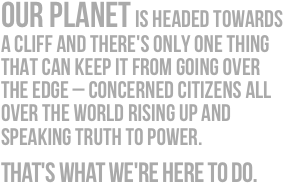by nathan thanki
Yesterday, a large group of civil society–mostly youth–took the voice and anger of the street into the halls of the UN. While it could never have been a true #occupy–COP is inherently segregated into those with badges and those without; those with pink badges and those with yellow–the idea was still to say: enough is enough. You have had 20 years to negotiate a fair, ambitious, legal treaty. You have failed. We pass a vote of no confidence in you, governments of the developed world.
While there aren’t always clear good and bad guys in these negotiations (despite the US and Canada’s best efforts to be the absolute worst), there is a clear divide of North and South. The North has historically exploited the South, and has historically used up it’s share of natural resources and atmospheric space. All at the detriment of the South. All you need to do is see a flow chart diagram of money, trade, and resources to see. The wealth of the world accumulates in Europe, in North America, in Australia and Japan. But they can’t afford to pay for adaptation and mitigation? They tell the poor of the world to do it for themselves. They’ve gotten rich from burning mountains of coal and oceans of oil, but now they refuse to cut their emissions unless the poor take that burden too? Civil society is divided over whether or not this is a fair ask. The calls for “treaty now” are fine - so long as it is a fair treaty. The concern that some NGOs have is that demanding a treaty by 2015 for everyone is asking India and China to write off their hopes of tackling poverty. More than that, because of low ambition and loopholes, it writes off all our hopes of a livable world in the future.
The media, eager to feed the hatred that Europeans and Americans seem to have toward any kind of competitor – India, China, Iran, Brasil etc – are running with the theme: blame the big developing nations. The EU is loving this. They can split G77 unity by appropriating the calls of the island states and LDCs for emissions reductions, and point the finger at India. Some elements of civil society are helping: Avaaz ran an ad in the Financial Times that showed Africa burning, while grim reapers from USA, Canada, Russia and India floated overhead. So the march yesterday was somewhat split. There were back and forth shouts of “treaty now” and “equity now.”
As well as substantive differences, there were also procedural ones. Most of us were ready to get kicked out, to lose our badges, to stay there all night if need be. The whole point was to bring our voice to the door of the plenary. So most of us rejected the idea of moving the protest outside in exchange for no repercussions. Besides, I for one did not believe the UNFCCC secretariat and security. They’d tell you anything, sure. But then voices from within the protest began sowing the seeds of doubt. “You will not be able to come to subsequent COPs.” “You will be arrested by the South African police for trespassing.” The pressure to leave was too great. We weren’t kettled in, so the protest disintegrated until there were a few dozen left, stubborn as mules, to be removed by the guards. We let our protest be appropriated.
The same must not happen to our message. I understand that the Avaaz blunder is causing them some grief, but it was only an expression of an idea that seems to be gaining ground among civil soceity – that the blockers should be blamed and shamed. But, wouldn’t you block a suicide pact? It is better to frame it like this: who does a block actually benefit? Not China, not India, but the developed nations. Europe and the States, Australia, New Zealand and Japan. If it all falls to pieces, then hey presto – they don’t have to live up to their promises, and they don’t have to fulfill their responsibility. If it goes through as it stands, then it’s curtains for ambition, it’s curtains for AWG-LCA, and it’s curtains for the planet. The islands will sink, Africa will burn, the political status quo will remain. We can’t let our planet be taken hostage by the greedy, just like we can’t let our democracy be taken hostage by the greedy. Greed is the right term. Notice how the only thing the rich countries want to share with the poor is the responsibility to reduce emissions. They do not want to share their wealth, their technology, their patented intellectual property.
We should not help perpetuate the lies of the rich and powerful.
I implore activists and others engaging in the struggle to think. Think about who you represent and how. When you find yourself talking about urgency in the negotiations, ask; where are we urgently going, and who gets hurt aslong the way? Who suffers from a “better than nothing” EU deal? Think about who has already suffered from climate change. Think about who has already acted to stop it. Then think about who the real blockers are. Please consider the true grassroots. The millions living in poverty in India, China, Brazil. Are you seriously going to condemn them to death? Or are you going to stand with them against the real polluters?


